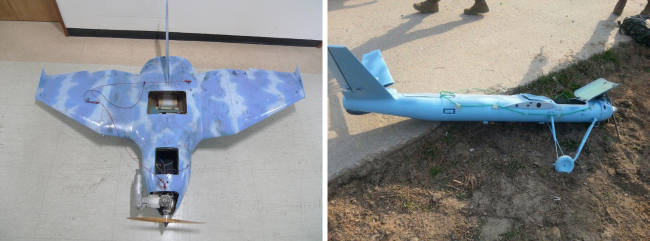[Newsmaker] Drones emerging as core military assets
By Korea HeraldPublished : April 2, 2014 - 21:01
Unmanned aerial vehicles are emerging as core military assets for intelligence gathering, surveillance and combat missions with many countries pursuing low-risk and less costly weapons systems.
The recent discovery of two crashed drones, presumably from North Korea, has drawn keen attention to the aircraft’s military capabilities and prompted calls for South Korea to strengthen its defense against Pyongyang’s drone-based military activities.
The recent discovery of two crashed drones, presumably from North Korea, has drawn keen attention to the aircraft’s military capabilities and prompted calls for South Korea to strengthen its defense against Pyongyang’s drone-based military activities.

In the development of combat drones, the U.S. is ahead of other nations given that it has long used them in battle zones in the Middle East and other regions to kill terrorist operatives and for other military operations.
One of the prominent U.S. military drones is the MQ-1 Predator. It has been mobilized for operations in conflict-laden regions including Bosnia, Pakistan, Libya, Iraq and Afghanistan since entering service in 1995. It is well-known for its use in killing many al-Qaida leaders.
The Predator was originally designed for reconnaissance missions, but it is also equipped with Hellfire missiles capable of destroying tanks and other armored vehicles. It can hover in the air for 24 hours.
An upgrade of the Predator is the MQ-9 Reaper, better known as a “hunter-killer.” In addition to reconnaissance missions, it can also carry out considerable strike missions with laser-guided bombs and air-to-air missiles.
For the high-altitude surveillance mission, the U.S. has deployed Global Hawk drones, which can detect and identify objects as small as 30 centimeters long.
South Korea plans to introduce four Global Hawks from 2018-2019 with a budget of 880 billion won ($832 million).
The single-engine Global Hawk can fly at an altitude of 18 kilometers or higher for 36 hours. With an operational range of 3,000 kilometers, it is capable of covering not only all of North Korea but also parts of China and other neighboring countries.
Israel is also famous for an assortment of military drones that it has exported to many countries including South Korea. China is also known to be developing a variety of military high- and low-altitude UAVs.
Global military powers including Russia and China have also been developing unmanned fighter jets. Last year, the U.S. Navy’s X-47B unmanned fighter carried out the first-ever carrier-based launches. It is now in the process of enhancing its landing and other basic technologies.
UAVs that are as small as birds are also being developed to carry out stealthy surveillance missions, experts say.
With the development of spying and combat drones, countries have sought to develop radar that can detect drones flying at low altitudes, and weapons that can shoot them down.
Amid the rise of drones as future military assets, critics argue that countries should exercise restraint in their use of drones as they have killed too many people and illegally entered other countries’ airspace.
By Song Sang-ho (sshluck@heraldcorp.com)
-
Articles by Korea Herald


















![[KH Explains] Hyundai's full hybrid edge to pay off amid slow transition to pure EVs](http://res.heraldm.com/phpwas/restmb_idxmake.php?idx=652&simg=/content/image/2024/04/18/20240418050645_0.jpg&u=20240418181020)

![[Today’s K-pop] Zico drops snippet of collaboration with Jennie](http://res.heraldm.com/phpwas/restmb_idxmake.php?idx=642&simg=/content/image/2024/04/18/20240418050702_0.jpg&u=)